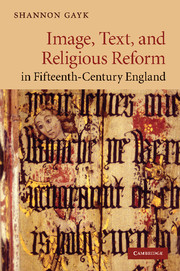Book contents
- Frontmatter
- Contents
- Acknowledgements
- List of abbreviations
- Introduction: reformations of the image
- 1 Lollard iconographies
- 2 Thomas Hoccleve's spectacles
- 3 John Lydgate's refigurations of the image
- 4 John Capgrave's material memorials
- 5 Reginald Pecock's libri laicorum
- Epilogue: words for images
- Notes
- Bibliography
- Index
- CAMBRIDGE STUDIES IN MEDIEVAL LITERATURE
Introduction: reformations of the image
Published online by Cambridge University Press: 17 November 2010
- Frontmatter
- Contents
- Acknowledgements
- List of abbreviations
- Introduction: reformations of the image
- 1 Lollard iconographies
- 2 Thomas Hoccleve's spectacles
- 3 John Lydgate's refigurations of the image
- 4 John Capgrave's material memorials
- 5 Reginald Pecock's libri laicorum
- Epilogue: words for images
- Notes
- Bibliography
- Index
- CAMBRIDGE STUDIES IN MEDIEVAL LITERATURE
Summary
Images and books have long been considered parallel modes of representation. Etymologically, “iconography” is to write with images. Classical authors and Renaissance poets alike appealed to and contested the Horatian literary formulation of ut pictura poesis (as is painting so is poetry). Throughout the Middle Ages, clerics often justified images as libri laicorum, or books for the laity. Early modern writers spoke of the sisterhood of the arts. And today we speak of “reading” images and of “visual literacy”; we ask our students to consider the imagery of poems; we may even utter the cliché that “a picture paints a thousand words.” Yet our muddled metaphors speak both to the surface sameness of and the underlying tension between these two modes of signification: even as we equate the two media, we know that images are not books, that seeing is quite different from hearing. Just as deeply held as our analogical association of image and word is our understanding that we must differentiate between the two types of signs. And indeed, attempts to understand the sometimes fraught sisterhood of visual and verbal signs have a long history. It is the purpose of this book to explore a set of English theorizations of this relationship in the fifteenth century.
Although religious images have never been without their critics, the end of the fourteenth century marked a significant shift in the language and audience of these critiques in England: for the first time, arguments against images were being put forth by lay men and women in the vernacular.
- Type
- Chapter
- Information
- Publisher: Cambridge University PressPrint publication year: 2010



